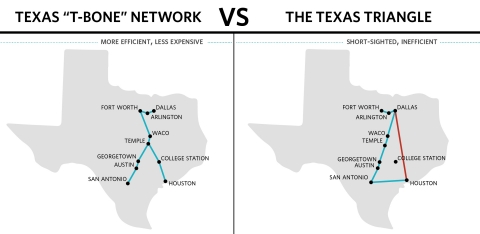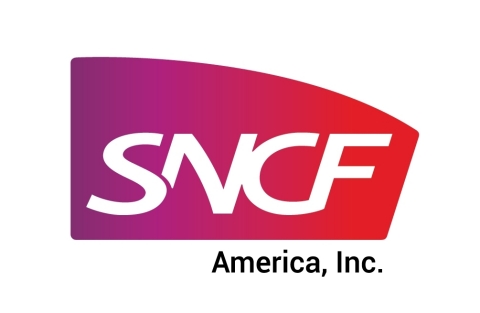AUSTIN, Texas--(BUSINESS WIRE)--SNCF America, Inc. has submitted comments in response to the Federal Railway Administration (FRA) Draft Environmental Impact Statement (Draft EIS) for the Dallas to Houston High-Speed Rail Project proposed by Texas Central Rail (TCR).
SNCF is a global leader in passenger transport services and one of the largest operators of high-speed rail in the world.
According to SNCF America, Inc. President & CEO Alain Leray, “The Texas Central Rail project has been designed around the best interest of a single company, not what is best for Texans or the state’s rail transportation future. If the federal government allows the Texas Central Rail project to move forward as proposed, it would likely close the door on the future of high-speed rail in communities like Austin, San Antonio, Waco and Temple, while placing huge risks on the shoulders of local, state and federal taxpayers.”
A full copy of SNCF’s America’s comments to the Draft EIS can be found HERE and highlights are summarized below:
-
Modern passenger rail services can only be successful if they are
conceived and planned as networks. In a state of 28 million
people, TCR’s proposal to construct a high-speed line that is limited
to Houston and Dallas will deprive other Texas cities of high-speed
rail options. A network approach generates demand from many different
cities, while the TCR approach is dependent on ridership only on the
I-45 corridor to sustain the profitability of its proposed high-speed
rail service. If the TCR line is built, Texas will lose the
opportunity to develop a network that serves cities along the
congested I-35 corridor, as well as the critical combined ridership
from all of these cities, which would share large portions of track
infrastructure and improve the prospects of running a more financially
viable operation.
SNCF America supports a “T-Bone” network configuration, which would provide high-speed rail access to 2.6 million more Texans (see attached diagrams). The “T-Bone” network would serve Houston, College Station, Dallas, Fort Worth, Waco, Temple, Georgetown, San Marcos, and San Antonio, a much more efficient way of connecting these cities than would be possible after the construction of the proposed TCR Dallas-Houston route. Once the proposed TCR is constructed, an enormous “Texas Triangle” of track covering 763 miles would be required to serve these cities, a far less efficient and more expensive configuration than the 480 mile “T-Bone.”
-
Operational revenues will likely not be sufficient to cover debt
service. SNCF America is aware of only two high-speed systems in
the world that cover infrastructure amortization with the revenues
they generate. These two systems (Tokyo-to-Osaka and Paris-to-Lyon)
have low infrastructure amortization costs because they were built
approximately a half-century ago. That is not reality in today’s
environment.
No country in the world operates a fully privately-funded high-speed rail infrastructure. Whether China, Germany, or Morocco, government funding is required to build the infrastructure.
Texas Central Partners has been forthcoming about exploring “all forms of capital available to private companies to finance debt for the project, including federal loan programs.” While TCR has declared that its project will be 100 percent privately funded, if loan payments fall short in the future due to underwhelming revenue, taxpayers would ultimately be liable for loans secured under Railroad Rehabilitation & Improvement Financing (RRIF) and/or Transportation Infrastructure Finance and Innovation Act (TIFIA), as cited in 1.1.2.2 of the Draft EIS.
The concept of private financing, while seductive, is virtually impossible to achieve with the financial debt-service burden of infrastructure that costs $45 million per mile to build.
- The Draft EIS is flawed because it fails to address the comparative advantages and disadvantages of high-speed (125-210 mph) versus higher-speed (max 125 mph) technologies for the Dallas-Houston corridor. Instead, it focuses on a single technology available from a single company. High speeds can’t be accommodated on tight curves and steep slopes. However, higher speeds can take tighter turns and can use much more of the existing rights of ways, reducing the need to use eminent domain. The cost of building rail lines for higher-speed trains would be $23 million per mile for two conventional electrified tracks, compared to $45 million per mile for two high-speed tracks. Before doubling the infrastructure costs (which could ultimately fall to taxpayers to cover) and using excessive eminent domain powers, the FRA should take a hard look at whether high-speed is possible, expected, or necessary for each segment of a proposed network.
-
The proposed TCR line does not serve the city centers of Dallas and
Houston, compounding the financial challenges. Convenience is a
critical competitive advantage for using high-speed rail, especially
among regular business travelers, but this is not the case with the
TCR plan. By locating stations on the outskirts of cities, TCR will
have to more vigorously compete with air and road travel.
Neither higher-speed, nor high-speed rail systems, should be expected to be successful and profitable if they do not serve city centers of their primary destinations or connect to established commuter train networks serving city centers. This should be a critical consideration of the FRA, as well as the potential environmental, economic, and social impacts of the project’s failure to serve city centers.
- TCR eliminates the opportunity for rail competition in Texas because Japanese technology is not compatible with standards currently used in the United States, the United Kingdom and the EU. While the Japanese N700 Series Shinkansen is safe, comfortable and reliable, Texas would be “marrying” Japanese technology, for better or for worse, and closing the door to competition.
About SNCF
SNCF is a global leader in passenger and freight transport services, with revenue of $41.2 billion in 2017, of which one-third on international markets. With 270,000 employees in 120 countries, SNCF draws on its foundations in French rail and its extensive experience as an architect of transport services. It aims to become the benchmark for mobility and logistics solutions in France and worldwide.
About SNCF America, Inc.
SNCF America, Inc. is a U.S. based company incorporated in the state of Delaware.




